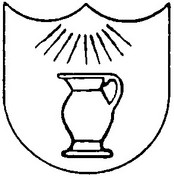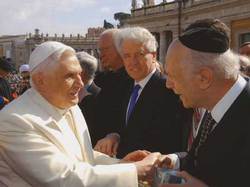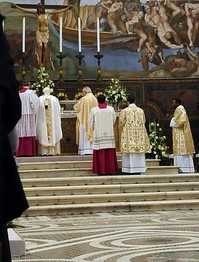 The saint on whom we reflect today is called Bede. He was born in
The saint on whom we reflect today is called Bede. He was born in
 Sacred Scriptures were the constant source of Bede's theological reflection. Having made a careful critical study of the text (we have a copy of the monumental Codex Amiatinus of the Vulgate, on which Bede worked), he commented on the Bible, reading it in a Christological vein, namely, re-uniting two things: On one hand, he listened to what the text was saying exactly, he really wanted to listen and understand the text itself; on the other hand, he was convinced that the key to understanding sacred Scripture as the unique Word of God is Christ and with Christ, in his light, one understands the Old and the New Testament as "a" sacred Scripture.
Sacred Scriptures were the constant source of Bede's theological reflection. Having made a careful critical study of the text (we have a copy of the monumental Codex Amiatinus of the Vulgate, on which Bede worked), he commented on the Bible, reading it in a Christological vein, namely, re-uniting two things: On one hand, he listened to what the text was saying exactly, he really wanted to listen and understand the text itself; on the other hand, he was convinced that the key to understanding sacred Scripture as the unique Word of God is Christ and with Christ, in his light, one understands the Old and the New Testament as "a" sacred Scripture.The events of the Old and New Testament go together, they are together the path toward Christ, though expressed in different signs and institutions (it is what he calls "concordia sacramentorum"). For example, the tent of the covenant that Moses raised in the desert and the first and second
 Another topic loved by Bede is the history of the Church. After having taken interest in the period described in the Acts of the Apostles, he reviewed the history of the Fathers of the Church and the councils, convinced that the work of the Holy Spirit continues in history. In the Cronica Maiora, Bede traces a chronology that would become the basis of the universal calendar "ab incarnatione Domini." Up to then, time was calculated from the foundation of the city of
Another topic loved by Bede is the history of the Church. After having taken interest in the period described in the Acts of the Apostles, he reviewed the history of the Fathers of the Church and the councils, convinced that the work of the Holy Spirit continues in history. In the Cronica Maiora, Bede traces a chronology that would become the basis of the universal calendar "ab incarnatione Domini." Up to then, time was calculated from the foundation of the city of Bede was also an illustrious teacher of liturgical theology. In the homilies on the Sunday Gospels and those of feast days, he develops a true mystagogy, educating the faithful to celebrate joyfully the mysteries of the faith and to reproduce them consistently in life, while expecting their full manifestation of the return of Christ, when, with our glorified bodies, we will be admitted in offertory procession to the eternal liturgy of God in heaven. Following the "realism" of the catecheses of Cyril, Ambrose and Augustine, Bede teaches that the sacraments of Christian initiation make every faithful person "not only a Christian but Christ." In fact, every time that a faithful soul receives and guards the Word of God with love, in imitation of Mary, he conceives and generates Christ again. And every time that a group of neophytes receives the Easter sacraments, the Church is "self-generated," or to use a still more daring expression, the Church becomes "Mother of God," participating in the generation of her children, by the work of the Holy Spirit.
Thanks to this way of making theology, interlacing the Bible, the liturgy and history, Bede has a timely message for the different "states of life":
a) For scholars (doctores ac doctrices) he recalls two essential tasks: to scrutinize the wonders of the Word of God to present it in an attractive way to the faithful; to show the dogmatic truths avoiding the heretical complications and keeping to the "Catholic simplicity," with attention to the small and humble to whom God is pleased to reveal the mysteries of the Kingdom.
b) For pastors, that for their part, must give priority to preaching, not only through the verbal or hagiographic language, but also valuing icons, processions and pilgrimages. Bede recommends to them the use of the vernacular, as he himself does, explaining in
c) For consecrated people who are dedicated to the Divine Office, living in the joy of fraternal communion and progressing in the spiritual life through ascesis and contemplation, Bede recommends to take care of the apostolate -- no one has the Gospel just for himself, but must regard it as a gift also for others -- either by collaborating with the Bishops in pastoral activities of various types in favor of the young Christian communities, or being available to the evangelizing mission to the pagans, outside their own country, as "peregrini pro amore Dei."
Placed in this perspective, in the commentary to the Canticle of Canticles, Bede presents the synagogue and the Church as collaborators in the propagation of the Word of God. Christ the Spouse desires an industrious Church, "bronzed by the fatigues of evangelization" -- clear is the reference to the word of the Canticle of Canticles (1:5), where the Bride says: "Nigra sum sed formosa" (I am brown, but beautiful) -- attempts to till other fields or vines and to establish among the new populations "not a provisional bell but a stable dwelling, namely, to insert the Gospel in the social fabric and the cultural institutions. In this perspective, the saintly Doctor exhorts the lay faithful to be assiduous to the religious instruction, imitating those "insatiable evangelical multitudes who did not even give the Apostles time to eat." He teaches them how to pray constantly, "reproducing in life what they celebrate in the liturgy," offering all actions as spiritual sacrifices in union with Christ. To parents he explains that also in their small domestic realm they can exercise "the priestly office of pastors and guides," by giving Christian formation to the children and states that he knows many faithful (men and women, spouses and celibates) "capable of an irreproachable conduct that, if suitably pursued, could approach daily Eucharistic communion ("Epist. ad Ecgbertum," ed. Plummer, p. 419).
 The fame of holiness and wisdom that Bede enjoyed already in life, served to merit him the title of "Venerable." He is thus called also by Pope Sergius I, when he wrote his abbot in 701 requesting to make him come temporarily to
The fame of holiness and wisdom that Bede enjoyed already in life, served to merit him the title of "Venerable." He is thus called also by Pope Sergius I, when he wrote his abbot in 701 requesting to make him come temporarily to Let us pray that also today there be personalities of Bede's stature, to keep the whole Continent united; let us pray so that all of us are willing to rediscover our common roots, to be builders of a profoundly human and genuinely Christian Europe.
(Wednesday General Audience, Rome, 18 February 2009)



